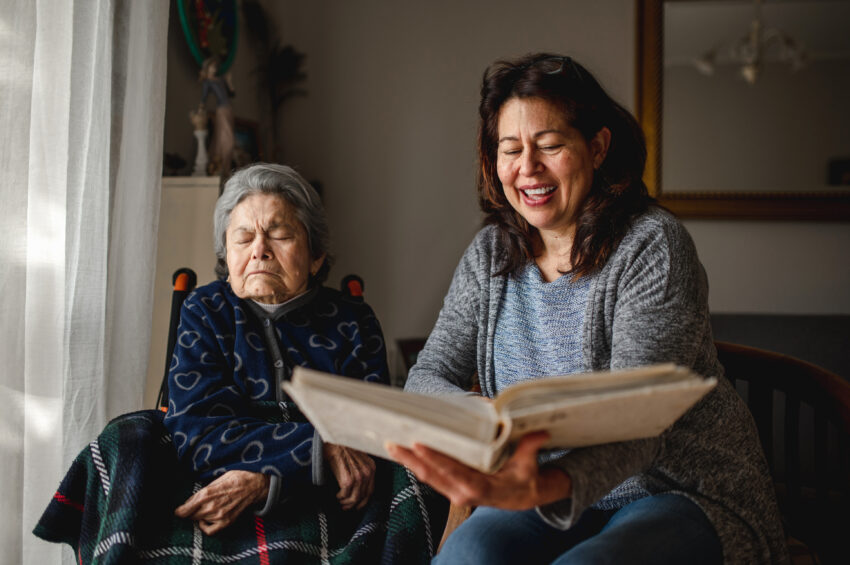
Share On Social!
Alzheimer’s disease is a condition that impairs brain function and, over time, can cause memory, cognitive, and behavioral issues and eventually lead to death.
The condition greatly impacts the health of the aging — especially Latinos.
14% of the American Latino population older than 65 are living with Alzheimer’s.
Alzheimer’s is projected to increase in older Latinos by 175% between 2018 and 2040, according to a new report, 2024 Alzheimer’s Disease Facts and Figures, from the Alzheimer’s Association.
Let’s explore the data from the report.
Alzheimer’s in America
Nearly 7 million older Americans are living with Alzheimer’s disease as of 2024.
That’s about the same as one out of every nine older Americans, according to the new report from the Alzheimer’s Association.
As the American population continues to age, the number of Alzheimer’s cases goes up.
By 2050, the number of new Alzheimer’s and other dementias are expected to double.
By 2060 An estimated 6.7 million people older than 85 are expected to have Alzheimer’s, which accounts for 48% of all people 65 and older with the disease.
Many of these older adults affected by the disease will be Latino.
Non-Medical Drivers of Health and Alzheimer’s
Alzheimer’s disease, which has no known cure, can start impacting the brain up to 20 years before symptoms start to show.
There are several risk factors associated with Alzheimer’s, including family history of the disease, genes, and genetic mutations.
Other risk factors are more modifiable and can be reduced by adopting a healthier lifestyle.
The associated cited a report by The Lancet Commission, which linked 40% of dementia cases to modifiable risk factors.
Like cancer and heart disease, lack of physical activity, smoking, high blood pressure, poor diet, and obesity can increase your risk for Alzheimer’s.
A 2022 study found that 37% of US cases were associated with modifiable risk factors, most commonly midlife obesity, low physical activity, and low educational attainment.
Many of these risk factors are especially prevalent in the Latino population due to non-medical drivers of health.
Issues — like where someone lives, quality of schools in their communities, exposure to harmful chemicals and other pollutants, and access to quality health care, high-paying jobs, and healthy food — can determine someone’s quality of life and impact their overall health and wellbeing.
The inequities lead to high rates of disease and obesity in minority populations like Latinos.
Nearly half of Latino adults are obese, according to the State of Obesity 2023: Better Policies for a Healthier America report.
Obesity is on the rise in Latino children with rates over 25% (nearly 30% of Latino boys and about 23% of Latino girls).
In 2018, Latino Americans were found to be 1.2 times more likely to be obese, according to the U.S. Department of Health and Human Services’ Office of Minority Health.
While access to healthy food plays a significant role in the development of obesity, lack of physical activity can also be partially to blame.
Physical activity can be extremely limited when there isn’t access to quality physical education in schools, communities equipped with safe areas to play, and not having parks within walking distance.
Some researchers believe that people who have had more years of formal education are at lower risk for developing Alzheimer’s, suggesting that formal education could help sustain brain function during the later stages of life, according to the association’s report.
When it comes to lack of education, populations like Latinos have many challenges to overcome to gain access to higher education opportunities.
Financial Burden of Alzheimer’s
Alzheimer’s dementia is known as a costly disease in more ways than one.
The cost to care for the estimated 6.9 million adults living with the disease is projected to reach $360 billion — costing $15 billion more than it did a year ago, according to the new report from the Alzheimer’s Association.
Most support for older adults living with Alzheimer’s in the US comes from family members, friends, or other unpaid caregivers.
Alzheimer’s and dementia caregivers account for 48% of all caregivers in the US.

More than 11 million Americans provide unpaid care for people living with Alzheimer’s and dementia, which amounts to 18.4 billion hours of unpaid labor valued at $346.6 billion.
Those figures boil down to an average of 31 hours of care per caregiver each week or 1,612 hours a year.
Care for someone with dementia or Alzheimer’s disease, which includes food and medicine, is estimated at around $400,000 as of 2023, with 70% of this amount being paid out-of-pocket by the unpaid family caregiver.
Medicaid and Medicare programs pay for 64% of Alzheimer’s and dementia health care and long-term care payments for a total of $231 billion. This leaves families to cover the remaining costs estimated at $91 billion.
Despite having financial assistance, family members of adults with dementia still face high deductibles, copayments, coinsurance, and other premiums insurance doesn’t cover.
On average, Medicare beneficiaries with Alzheimer’s pay $10,289 out of pocket every year for care insurance doesn’t cover.
For a breakdown of insurance coverage, expenses, and cost of care download the full version of the report.
Latino Alzheimer’s Caregiving
Latinos account for 21% of all family caregivers in the US, according to the National Institutes of Health.

While Latinos represent a small portion of all Alzheimer’s caregivers, many of them care for a family member at home.
Nearly half of Black and Latino people living with dementia live with adult children (47.1%).
Latino and Black caregivers report spending more time caring for someone with dementia.
Latinos, along with Black and Asian American dementia caregivers reportedly have more care demands, less outside help, and experience greater depression compared to white caregivers.

Black and Latino caregivers are more likely to coordinate health care at least once per day than white caregivers at 43%, 45%, and 31%, respectively.
The willingness to coordinate health care contributes to the overall time spent on caregiving with Latino caregivers giving an average 25 hours a week of their time to caregiving.
This has led to higher levels of stress in Latino caregivers.
71% of Latino caregivers feel stressed by coordinating care, 57% have expressed difficulties and challenges with coordinating care, and 70% have trouble finding support for their needs as a caregiver.
Some of the top stressors among dementia caregivers are worries about costs and expenses (the top stressor for Latinos at 42%), finding adequate care, understanding recommended treatments, and finding respite care.
Help for Latino Alzheimer’s Caregivers in the Healthcare System
Over half of caregivers say they bring up these challenges with a healthcare professional.
Research finds that three out of four caregivers have little to no familiarity with having a “care navigator,” despite 50% of caregivers turning to someone in their physician’s office or hospital for support and services.
Whether it’s assistance from nurses, social workers, physician assistants, community health workers, other caregivers, or navigators, only 51% of Latino caregivers seek help navigating care.
Additionally, caregivers, including Latinos, expressed a need for care navigators to have a good grasp on the background and culture of the person being cared for.


Much of the lack of care navigation is due to it not being offered.
Of the caregivers surveyed, four in five said that access to a care navigator would influence their choice of care provider, including 44% of Latino caregivers, with 22% believing that working with one could make caregiving less expensive.
The survey also found that Latino and Black caregivers had poorer health prior to caring for a spouse with dementia than those from the same ethnic groups who didn’t become caregivers.
Caregivers who are Latino also have a slightly lower physical wellbeing than white caregivers.
These disparities may be explained by the significance of family values in the Latino culture, which places the needs of family above the needs of an individual.
The lack of help sought by Latino caregivers may be due to culturally inconsistent expectations of healthcare systems and the provider’s assumptions that families are the ones caring for Latinos with dementia.
For more about the disparities, stressors, and challenges associated with Alzheimer’s caregiving download a full copy of the report.
The Future of Altheimer’s Care Navigation
Not having access to equitable care navigation can have huge ramifications for people living with dementia or Alzheimer’s, as well as their caregivers.
Lack of care navigation can result in delayed detection, diagnosis, and treatment of dementia, cause difficulties in care transition that lead to higher costs, worse health outcomes, and decreased quality of life, and give caregivers fewer resources and access to community-based services and education programs.
“Dementia health care is a complex maze composed of primary care providers, specialists, social services, medication management and caregiver support,” said Dr. Sam Fazio, senior director, psychosocial research and quality care, Alzheimer’s Association. “As the number of individuals living with Alzheimer’s continues to grow, ensuring patients, their caregivers and families have a clear understanding of how to navigate dementia care resources is critical to improving health outcomes.”
The survey results included in the Alzheimer’s Association’s report highlight three aspects to help improve dementia care navigation:
- “Formalizing the dementia care navigator role and increasing navigator proficiency in dementia car.”
- “Scaling and expanding access to dementia care navigation programs.”
- “Creating direct lines to dementia care navigators.”
To formalize the dementia care navigator role, health professional organizations that staff workers such as nurses, physicians, nursing assistants, aids, direct care workers, and home health aides should create a framework to “integrate dementia care navigators into existing teams and workflows.”
To grow the care navigation workforce, the association suggests using community health workers, social workers, and home health aides who are suited to the role and supplementing their lack of education with comprehensive training and other resources.
One of the greatest barriers to care navigation is the lack of incentivization in dementia care.
An alternative payment system for reimbursement could help streamline future care coordination.
Getting the word out about care navigators can be done through community outreach involving leveraging community resources, use of social media, and health care settings to let caregivers know what support they have available to them.
According to survey takers, navigators should be more easily accessible to caregivers.
Creating a direct 24/7 helpline that connects caregivers to care navigators could bridge the gap between caregivers and the support they need.
“There is growing momentum in this country to enhance dementia care navigation,” Fazio said in the accompanying news release. “Dementia care navigation programs have shown they can be a huge benefit to people living with dementia and their caregivers. Unfortunately, these programs are not widespread across the country.”
“We hope this report will be a catalyst for change.”
Clinical Trials and Alzheimer’s
While there is no cure for Alzheimer’s, advances in science have identified biomarkers in individuals that make them good candidates for clinical trials that aim to address risk factors that may slow or delay cognitive loss.
Biomarkers have also helped the development of new treatments that help researchers to better understand the disease and can help target certain therapies.
However, participation in Alzheimer’s and dementia clinical trials remains low, especially among populations such as Latinos.
Clinical trials are studies with volunteers that help researchers learn how to slow, manage, and treat different diseases like Alzheimer’s.
How can you find open clinical trials to participate in?
Look to Salud America!’s clinical trial page to find a research opportunity or learn from role models who have participated in a trial.
“Volunteers who participate in clinical trials have the potential to help themselves, and contribute to the development of new treatments for people in the future,” said Dr. Amelie Ramirez, director of Salud America! and the Institute of Health Promote Research at UT Health San Antonio.
Those looking for opportunities based in San Antonio can search the Mays Cancer Center at UT Health San Antonio’s Find a Clinical Trial database to learn more about available clinical trials and eligibility requirements.
On a national level, visit clinicaltrials.gov to find a clinical trial near you.
By The Numbers
25
years
of life expectancy between some U.S. cities.



